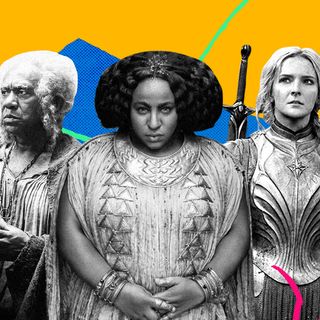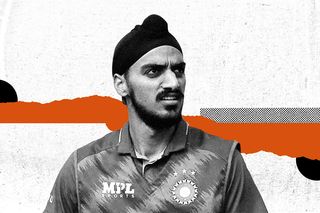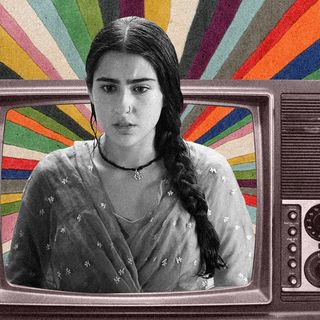
Hate Against Cricketer Arshdeep Singh Shows the Pitfalls of Sports Nationalism
A large part of social media termed the young cricketer a “Khalistani” for a dropped catch, showing how majoritarianism runs deep in sports.

In a nail-biting moment last night, the Pakistan cricket team defeated India’s in a Super-Four encounter in the ongoing Asia Cup Tournament in Dubai — with just one ball to remain. Naturally, then, Indian fans were beyond dejected when the defeat came in. They soon started looking for reasons and explanations for their defeat. In their lookout for singular scapegoats to take the blame for the team’s defeat, they found cricketer Arshdeep Singh as a suitable target. The 23-year-old bowler had dropped a vital catch earlier in the game. And he is Sikh.
An India-Pakistan cricket match always drives up emotions on both sides of the border. In fact, Indian fans and brands have derived a lot of humor at the expense of the Pakistani side over the years, using the term mauka, referring to a commercial from a few years ago about Pakistan never winning against the Indian side in the ICC World Cup. Given the history between the two countries, the rhetoric is one that’s driven by nationalistic fervor, and it often devolves into accusations of being anti-national, seditious, or traitorous being thrown around with ease.
The phenomenon calls into question the very basis on which sports takes place — often, in the name of nationalistic pride, fans define who gets to represent the country itself. Sport is a form of diplomacy; teams embody a country’s values and demographic. But when this composition is challenged and individual players are made to answer for their own loyalty, it isn’t just the sport that suffers — but the idea of a nation too.
Soon after the defeat, then, a sizeable section of fans and cricket-watchers began questioning Singh’s loyalty to the country. They branded him a “Khalistani” — a name given to militant Sikh separatists — for his religion and alleged that he was in fact being loyal to his cause as a separatist by helping the “enemy” win. Fans overlooked the fact that Singh had the most economical bowling figures by an Indian bowler in the match, or that even when the winning team required only seven runs in the final over it was his bowling that dragged the match till the penultimate ball. His religion, however, was enough for spectators to unleash their abuse and vitriol at him.
The abuse got so bad that former cricketers and Singh’s teammates had to publicly come out in his defense. In response, some people claimed that they had a right to criticize Singh’s dropped catch since he was an Indian player and that fans who attach so much of their emotion to the sport were bound to be angry at a performance like this. Indeed, there have been times when fans have been enraged even at legends like Sachin Tendulkar or Sourav Ganguly due to their dismal performances. However, as privileged-caste Hindus, those players and others fitting in the dominant imagery of Indian nationalism were never targeted for their religion or caste the way Singh was, and therein lies a fundamental difference between their experience and what Singh was subjected to.
Related on The Swaddle:
ESPN’s Cricket Site Announces It Will Use Gender-Neutral Sports Terms
Cricket isn’t the only sphere where an Indian sportsperson who wasn’t privileged by caste or religion has faced trolling and attacks after a bad performance. Last year, after the Indian Women’s Hockey Team lost the semifinal match in the Tokyo Olympics, casteist men celebrated jubilantly in front of star player — and Dalit — Vandana Katariya‘s house in Dehradun, exclaiming that there were too many Dalits in the team and that they should be thrown out of all sports teams in the country. Notably, Vinod Kambli, a Dalit cricketer who was a contemporary of Tendulkar at one point, is speculated to have eventually lost his position in the team due to his caste status. Nationalist sports fanaticism thus challenges every player who does not fit in the dominant, majoritarian imagination of the nation and its people.
But the problem of sport-nationalism fueling hatred isn’t just limited to India. A couple of months before the Olympics began, English football fans unleashed a brutal attack, including physical attempts at assault, on three black players. Marcus Rushford, Jadon Sancho, and Bukayo Saka had all missed their penalty kicks in the final match of the Euro 2020 tournament, and soon after started receiving racist attacks both online and offline. A study by FIFA revealed that Rashford and Saka were the most viciously abused footballers both before and after the Euro 2020. Most of that hate came from English fans themselves.
Racism and bigotry by nationalist football fans are what also led to German midfielder Mesut Ozil’s retirement from international football. Ozil, who is of Turkish descent, announced his decision online, saying, “I will no longer be playing for Germany at (the) international level whilst I have this feeling of racism and disrespect. I used to wear the German shirt with such pride and excitement, but now I don’t.” Ozil was targeted for his Turkish lineage and was also dropped from the starting XI in the 2018 FIFA World Cup.
Both Rashford and Ozil are footballers of immense caliber. That their race compelled them to answer questions about their loyalty indicates that there is little space for diversity in fans’ imaginations of their favorite teams. The hate that Singh received in the aftermath of the match then shows that competitive sport between countries becomes a ripe playing field for bigotry. It also represents a majoritarian impulse to define the nation — and its rightful inhabitants — using sports as a tool for doing so.
Even if nationalist sports fans may begrudgingly tolerate the inclusion of someone whose identity does not align with their idea of their nation, they waste no time in reminding the players in question that they do not belong. Sports nationalism, then, is just a front to dangerous majoritarian exclusion — one that belies the spirit of sportsmanship itself, and threatens to let hatred engulf all those who are involved for the love of the game.
Amlan Sarkar is a staff writer at TheSwaddle. He writes about the intersection between pop culture and politics. You can reach him on Instagram @amlansarkr.
Related


Woe Is Me! “I Have Lots of Goals But No Motivation. How Do I Gather the Energy to Try?”
